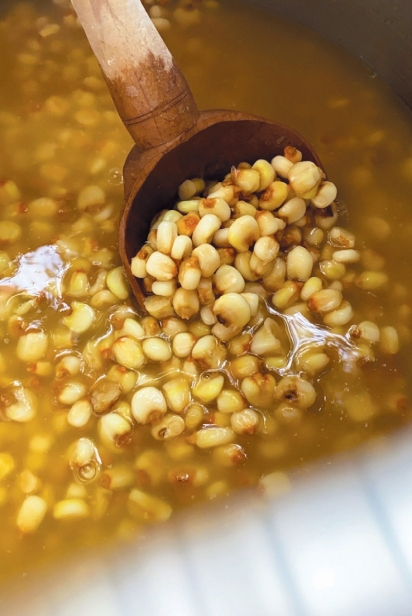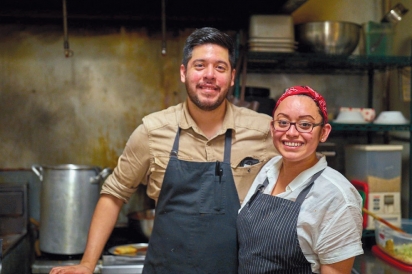From Maize to Masa - Expressing Culture Through Nixtamalization
How nixtamalization expresses culture and cuisine through corn
Maize—or corn, as we commonly know it—is at the heart of Mexican cuisine. The staple, whose origins can be traced back thousands of years to Mesoamerica, has nourished generations and is the foundation of many Mexican foods, from tortillas to tamales. Yet before it can be used, corn must first undergo a transformation.
Through an ancient process called nixtamalization, dried maize is cooked and steeped in an alkaline solution, then rinsed. This removes the tough exterior layer, known as the pericarp, making the kernels softer and more palatable. The treatment also boosts the grain’s nutritional value, increasing its calcium, riboflavin and niacin content. The resulting product, nixtamal, can then be ground into soft masa, or dough, for use in a multitude of preparations.
Nixtamalization was invented by Mesoamericans and although the precise date and geographic location is unknown, archaeological sites dating to around 1000 BC point to the use of alkali from residues found in ceramics, writes Dr. Amanda Gálvez of the National Autonomous University of Mexico (UNAM) in Nixtamal: A guide to masa preparation in the United States. The technique lives on today in homes and kitchens in and outside of Mexico, including right here in Houston, where local chefs with Mexican and Central American roots are working to preserve it.
“Nixtamalization is something from Mexico for the world and it’s very unique to our region,” says Chef Hugo Ortega, who owns Hugo’s, Caracol, Xochi and Urbe. “The process is very simple but it’s full of history, tradition and culture most of all.”
Ortega was born in Mexico City but spent part of his childhood in the small village of Progreso, in the Mixteca region. He vividly remembers watching his grandmother making nixtamal and grinding it by hand on her metate, or millstone. “I had the opportunity to see how the unique friction created by her strength, her temper and her wisdom yielded this dough that was smooth, soft, almost creamy,” Ortega says. The masa would then be used to make tortillas and other preparations like atole, a traditional cornmeal beverage.
Years later, the process remains relatively unchanged, even when his restaurants do it at a much larger scale and with modern equipment. “Good things are not easy to reinvent,” he says.
Nixtamalization is typically a two-day process that begins in the afternoon or evening. Corn kernels are cooked in water and calcium hydroxide (cal, in Spanish) and are left to rest overnight. With only three ingredients, the recipe seems simple, but factors such as the type of corn (Mexico has some 60 heirloom landraces of maize), what it’s being used for, and the cook’s own experiences play a role in the process.
At Tatemó, a Houston tortilleria, mill and soon to be restaurant owned by Chef Emmanuel Chavez and Megan Maul, corn cooks at about at about 152°F for 30 to 45 minutes, depending on its starch content. “Our main objective is to gelatinize the starches in the corn and not destroy them during the boiling process,” says Chavez. The gelatinization is what gives elasticity to the masa. Blue and red maize varieties are starchier and more sensitive, for example, so they require less cal and a shorter cooking time to preserve their color and texture. Understanding these nuances is like making a dressing: You may have a recipe but “it’s when you start trying and seeing what works and what doesn’t that puts it into perspective,” says Chavez.
Chavez was born in Mexico and moved to Houston at age 10. His parents worked in Tex-Mex restaurants. “My whole life I believed a tortilla came from a bag of flour. When you’re young, you don’t really ask questions because you don’t care,” he says. “You see your mom making [tortillas] and that’s how it’s done, and you grow up with that idea.”
But in his late 20s, when planning a pop-up for Hurricane Harvey relief with Chef Eric Rivera of Addo in Seattle, Chavez included Maseca, the ubiquitous instant corn masa flour, on his ingredient list. Rivera “flipped out” and told Chavez that he had to understand his roots. That encounter set Chavez on a path of discovery. He read everything he could and asked questions in groups devoted to promoting the culture and consumption of maize, such as Fundación Tortilla, a nonprofit based in Veracruz.
“I just fell in love with it. It was very addictive, too, to see how little I knew of the actual process and the tastes and textures, and how everybody has their own tortilla. To this day, I’m two years in and I feel like I don’t know anything,” says Chavez.
The learning doesn’t stop. Even Ortega, who has been at it for longer, credits Mexican Chef Atzin Santos, who owns Mexico City restaurant Limosneros and a tortilleria and molino called Maices Nativos, with expanding his knowledge about maize varietals and how to nixtamalize them.
Chavez and Maul’s original idea was to open a restaurant, but the pandemic put a halt to their plans. Having already purchased equipment and pounds of corn, the couple starting nixtamalizing and making tortillas to sell to friends and family on Instagram. Two dozen became 10 dozen and soon they landed at the Urban Harvest Farmers Market, where they sell masa and some 100 dozen tortillas every Saturday. They also sell to restaurants such as Better Luck Tomorrow, Tenfold Coffee, and Koffeteria.
“We weren’t really expecting people to understand why a tortilla costs 77 cents when you can go to the store and get about a hundred for two dollars, so it was a great experience to teach people [about] where the seeds were coming from, why it’s important from the nutrition aspect, and the actual ecosystem of appreciation of culture and the farmers,” said Chavez.
This fall, the pair will open a brick-and-mortar, where they’ll hold multi-course dinners showcasing the diversity of heirloom corn in dishes like infladitas and masa ice cream.
After steeping in the alkaline solution overnight, the corn must be thoroughly rinsed. In the kitchen of Papalo Mercado in downtown’s Finn Hall, Chef Nick Vera demonstrates how he rinses thousands of deep-blue-hued kernels of Cónico Azul, a blue corn from the central valley of Mexico. He moves the kernels around with his hands, making figure eights, to remove the outer layers and any impurities. Once rinsed and strained, the nixtamal is ready to grind.
Vera knew of nixtamalization but he learned more about the process five years ago while working as sous chef at Ortega’s Xochi. There, he learned about all the factors that influence corn’s flavor, texture and color, such as the mineral content of the soil, the altitude, the humidity and the season. “It was a new world,” he says.
He and Stephanie Velasquez, who also worked at Xochi, opened Papalo Taqueria to lines of eager diners in March 2020. Two weeks later, everything shut down due to the pandemic. After a year, the couple decided to open Papalo Mercado and sell Mexican products, including aguas frescas, pan dulce and nixtamalized corn tortillas, which are sold at their downtown location, where you can also try their tacos, and at Henderson & Kane.
Echoing Chavez, Vera thinks that while each kitchen has a nixtamalization recipe, the process relies on the cook’s intuition. “If you have several years of doing it, you know it’s ready when you know it’s ready,” says Vera. To perfect the process, he adds, one must follow the recipe, practice, make mistakes, and practice some more.
To grind the nixtamal into masa you need a mill, or molino. There are many types available, including countertop models suitable for home use. Papalo’s Vera describes his molino as “craft,” a gift from his father, who ordered it from a family in Puebla that makes mills. Sitting next to it is a large bowl full of nixtamalized Olotillo Blanco, a white corn from the mountainous coast of Oaxaca. Next to the bowl, the two volcanic stones that will grind the nixtamal into dough rest in a bath of ice water. Keeping the stones cool prevents them from heating up too fast due to friction and, in turn, cooking the nixtamal. Vera loosens the knuckles and carefully inserts the stones. The tightness of the knuckles will determine the coarseness of the grind.
For Tatemó’s Chavez and Maul, learning to use their machine was one of the hardest things. “It’s like driving a car: Until you get in the car and go, you don’t really know what you’re doing.” They didn’t know anyone who owned machinery and even though there are a lot of resources out there, they made a lot of mistakes. They didn’t let them discourage them.
On a September morning, Chavez grinds nixtamalized corn and hands me a small piece of masa. It’s soft and warm, and once pressed between our fingers it’s smooth, not at all sticky. Once the masa is made, it can take many shapes: flat and round tortillas, oval-shaped tlacoyos, chochoyotes (corn dumplings) and more.
In the case of tortillas, they can be pressed by hand. That’s a good method if you are making just a few but a time-consuming process if you need to make large quantities. For that, the masa can be put through a machine that slowly rolls the dough flat and cuts out the round tortilla. Either way, eaten rolled up, fresh off the flat top, their softness and toasty corn flavor are nothing short of amazing.
It may seem simple, but every step that goes into making a good maize product is a laborious process, from the planting and harvesting of the seed to nixtamalization. And this group of Houston chefs is on a mission to show us its value. It’s not just about making a tortilla; it’s about respecting the technique and the work that goes into it.
“[Nixtamalization] is a legacy that has been left to us, so it’s our responsibility to care for it. If not, who’s going to do it? It’s that simple,” says Ortega. “Those of us who can dedicate our lives to Mexican gastronomy ... have a responsibility to take care of our heritage. It’s an obligation, not a question of whether we want to do it or not.”











